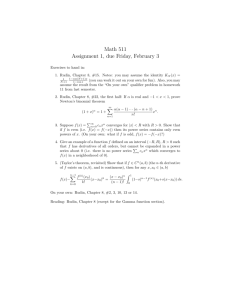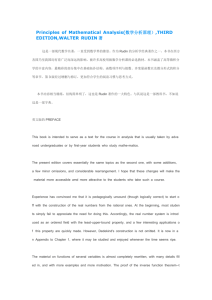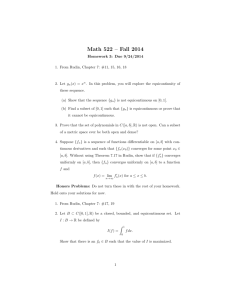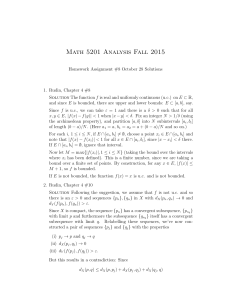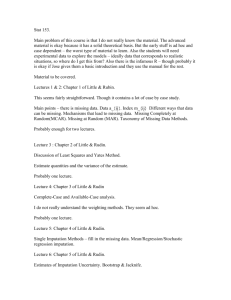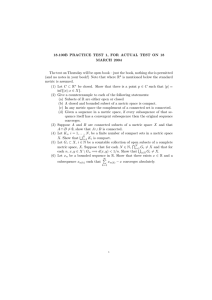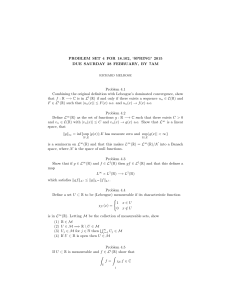18.100B – SPRING 2004 Last updated:- 9 May, 2004. 1. Announcements
advertisement
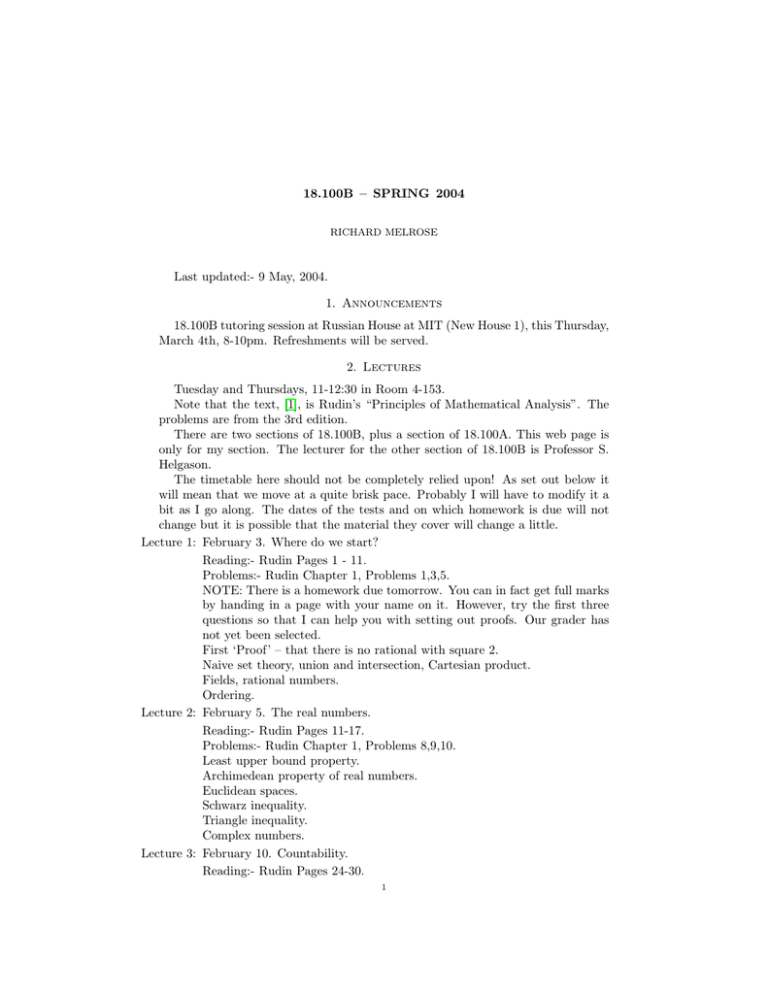
18.100B – SPRING 2004
RICHARD MELROSE
Last updated:- 9 May, 2004.
1. Announcements
18.100B tutoring session at Russian House at MIT (New House 1), this Thursday,
March 4th, 8-10pm. Refreshments will be served.
2. Lectures
Tuesday and Thursdays, 11-12:30 in Room 4-153.
Note that the text, [1], is Rudin’s “Principles of Mathematical Analysis”. The
problems are from the 3rd edition.
There are two sections of 18.100B, plus a section of 18.100A. This web page is
only for my section. The lecturer for the other section of 18.100B is Professor S.
Helgason.
The timetable here should not be completely relied upon! As set out below it
will mean that we move at a quite brisk pace. Probably I will have to modify it a
bit as I go along. The dates of the tests and on which homework is due will not
change but it is possible that the material they cover will change a little.
Lecture 1: February 3. Where do we start?
Reading:- Rudin Pages 1 - 11.
Problems:- Rudin Chapter 1, Problems 1,3,5.
NOTE: There is a homework due tomorrow. You can in fact get full marks
by handing in a page with your name on it. However, try the first three
questions so that I can help you with setting out proofs. Our grader has
not yet been selected.
First ‘Proof’ – that there is no rational with square 2.
Naive set theory, union and intersection, Cartesian product.
Fields, rational numbers.
Ordering.
Lecture 2: February 5. The real numbers.
Reading:- Rudin Pages 11-17.
Problems:- Rudin Chapter 1, Problems 8,9,10.
Least upper bound property.
Archimedean property of real numbers.
Euclidean spaces.
Schwarz inequality.
Triangle inequality.
Complex numbers.
Lecture 3: February 10. Countability.
Reading:- Rudin Pages 24-30.
1
2
Lecture 4:
Lecture 5:
Lecture 6:
Lecture 7:
Lecture 8:
RICHARD MELROSE
Problems:- Rudin Chapter 2, Problems 2,3,4.
Maps, surjectivity, injectivity, bijectivity.
Equivalence of sets
Finite, countable, uncountable, at-most-countable and infinite sets.
Countability of the integers (duh).
A countable union of countable sets is countable.
Cartesian product of two countable sets is countable.
Countability of the rationals.
The uncountability of the set of sequences with values in {0, 1}.
Amusement for the over-prepared. Prove Sylvester’s theorem. Suppose
a and b are non-negative integers. Show that every integer larger than
ab − a − b can be expressed as a linear combination ma + nb with m and n
non-negative integres.
February 12. Metric spaces, open sets.
Reading:- Rudin Pages 31-35.
Problems:- Rudin Chapter 2, Problems 9a, 9b, 9c, 11,
Euclidean metric, discrete metric and supremum metric.
Open balls in a metric space.
Open subsets of a metric space.
Unions and finite intersections of open sets are open.
Open balls are open (duh).
Limit points and closed sets.
February 19 (Monday schedule on February 17). Closed sets.
Reading:- Rudin pages 34-36.
Problems:- Rudin Chapter 2, Problems 10, 22, 23.
Complements of closed sets are open and vice versa.
Closure of a set.
Relatively open subsets.
Compact sets are closed.
February 24. Compact sets.
Reading:- Rudin Pages 36-38.
Problems:- Rudin Chapter 2, Problems 12, 16, 25.
Countable intersection property
Infinite subsets of compact sets have limit points
February 26. Compact subsets of Euclidean space
Reading:- Rudin Pages 38-40.
Problems:- Rudin Chapter 2, Problems 24, 26, 29.
Compactness of the unit cube.
Heine-Borel theorem
Weierstrass’ theorem
Connectedness of sets.
March 2. Completeness.
Reading:- Rudin Pages 42-43, 47-55.
Problems:- Rudin Chapter 2, Problems 19, 20, 21.
Sequential compactness.
Convergence of sequences.
Cauchy sequences.
18.100B
Lecture 9:
Lecture 10:
Lecture 11:
Lecture 12:
Lecture 13:
Lecture 14:
Lecture 15:
Lecture 16:
3
Completeness.
Completeness of Euclidean spaces.
March 4. Sequences and series.
Reading:- Rudin Pages 55-69, 71-75.
Problems:- Rudin Chapter 3, Problems 2, 7, 12, 16.
Completeness of compact spaces.
Sequential compactness.
Did not do series, root, ratio tests, absolute convergence.
March 9. Continuity.
Problems:- Rudin Chapter 4, Problems 1, 4, 15.
Reading:- Rudin pages 83-86.
Limits of functions at a point.
Continuity of functions at a point.
Continuity of composites.
Continuity of maps.
March 11. Continuity and sets.
Reading:- Rudin pages 85-93.
Problems:- Rudin Chapter 4, Problems 1, 4, 15.
Continuity and open sets.
Continuity and closes sets.
Continutiy and components.
March 16. Continuity and compactness.
Reading:- Rudin pages 89-93.
Problems:Continuity and compactness.
A continuous function on a compact set has a maximum
Continuity and connectedness.
A continuous function on an interval takes intermediate values.
March 18. First in-class test. Covers all material in Lectures 1-10.
March 30. Differentiability.
Reading:- Rudin pages 103-107.
Problems:Differentiability and the derivative.
Differentiability implies continuity.
Sums and products.
Chain rule
Maxima and minima.
April 1. (Professor Helgason will lectures, since I will be away.) Mean value
theorem.
Reading:- Rudin pages 107-110.
Mean value theorems.
Increasing and decreasing functions
l’Hopital’s rule.
Higher derivatives
Taylor’s theorem.
April 6. Riemann-Stieltjes integral defined.
4
Lecture 17:
Lecture 18:
Lecture 19:
Lecture 20:
Lecture 21:
Lecture 22:
Lecture 23:
Lecture 24:
Lecture 25:
RICHARD MELROSE
Reading:- Rudin pages 120-124.
Problems:Upper and lower sums.
Upper and lower integrals.
Integrability.
Refinement
Integability criterion.
April 8. Integrability of a continuous function.
Reading:- Rudin pages 124-127.
Continuous functions are Riemann-Stieltjes integrable.
Monotonic functions are R-S integrable w.r.t. continuous length functions.
Finite discontinuities.
Continuous function of R-S integrable function is R-S integrable.
April 13. Riemann-Stieltjes integral.
Reading:- Rudin pages 128-133.
Properties of the integral
April 15. Fundamental theorem of calculus.
Reading:- Rudin pages 133-136.
Integration by parts
FTC version 1
FTC version 2
April 22 (April 20 is a holiday). Sequences of functions.
Reading:- Rudin pages 143-151
Problems:Pointwise convergence of sequences of functions
Uniform convergence
Cauchy criterion
Uniform convergence and continuity
April 27. Second in-class test
April 29. Uniform convergence.
Reading:- Rudin pages 150-154.
Problems:The metric space of bounded continuous functions on a metric space.
Uniform convergence and integration.
Uniform convergence and differentiation.
May 4. Equicontinuity
Reading:- Rudin pages 154-161.
Equicontinuity and compactness.
Stone-Weierstrass theorem.
May 6. Power series
Reading:- Rudin pages 172-180
Convergent Taylor series.
Analytic functions.
May 11. Fundamental theorem of algebra.
Reading:- Rudin pages 180-185.
Exponential, logarithm and trigonometric functions.
18.100B
5
Fundamental theorem of algebra.
Lecture 26: May 13.
Final review, with some indications of what more we could have done
with a little time. I will give you some idea of the structure of the final
examination. Also I will try to give you an idea of the relationship of the
material in this course to other mathematics courses.
Final Exam Is on Thursday May 20, 1:30PM-4:30PM in Walker.
3. Office hours
I will have an office hour for 18.100 on Wednesdays 9:30 – 10:30 in 2-174. Try
to speak slowly, I may not be fully awake.
Your intrepid grader is Nikola Penev, who will have an office hour at 5-6PM on
Mondays in 2-146.
From Russian House Vice-President, Eugenia Lyashenko:Russian House at MIT is happy to hold tutoring sessions for 18.100B every
Thursday, 8-10pm.
We organize this because the freshmen/sophomores residents of our house usually take non-mainstream science classes like 18.100B and there is a tradition for
our upperclassmen and graduate social members to help them study this more challenging material. We wish to expand this rich intellectual experience to other MIT
students. Light refreshments will be provided as well!
4. Homework
From now on will be due on Tuesdays – so that it can be graded by the following
Thursday. For the next week I will accept homework in my office until 12 on
Wednesday. To be put in a bin in 2-108 before Noon – there will be a box somewhere
just inside the door.
(1) due February 5: Rudin Chapter 1, Problems 1,3,5.
Exercise 1 If s and r 6= 0 are rational then so are s + r, −r, 1/r and sr (since
the rationals form a field). So if r is rational and x is real, then x + r
rational implies (x+r)−r = x is rational. An irrational number is just
a non-rational real number, so conversely if x is irrational then x + t
must be irrational. Similarly if rx is rational then so is (xr)/r = x;
thus if x is irrational then so is rx.
Exercise 3 (a) If x 6= 0 then x−1 exists and if xy = xz then
y = (x−1 x)y = x−1 (xy) = x−1 (xz) = (x−1 x)z = z
using first (M5) then (M2), (M3), the given condition, (M3) and
(M5).
(b) Is (a) with z = 1.
(c) Multiply by x−1 so x−1 = x−1 (xy) = (x−1 x)y = 1y = y using
associativity and definition of inverse.
(d) The identity for x−1 = 1/x, x · x−1 gives by commutativity
x−1 · x = 1 which means 1/(1/x) = x by the uniqueness of
inverses.
Exercise 5 If A is a set of real numbers which is bounded below then inf A is by
definition a lower bound, i.e. inf A ≤ a for all a ∈ A and if inf A ≥ b
6
RICHARD MELROSE
for any other lower bound b. We already know that if it exists it is
unique. Now if A is bounded below then
(1)
−A = {−x; x ∈ A}
is bounded above. Indeed if b ≤ x for all x ∈ A then −b ≥ −x for all
x ∈ A which means −b ≥ y for all y ∈ −A. Now, if sup(−A) is the
least upper bound of −A it follows that − sup(−A) is a lower bound
for A since
x ∈ A =⇒ −x ∈ −A =⇒ sup(−A) ≥ −x =⇒ − sup(−A) ≤ x.
As noted above, if b is any lower bound for A then −b is an upper
bound for −A so −b ≥ sup(−A) and b ≤ − sup(−A). This is the
definition of inf A so
inf A = − sup(−A).
(2) due February 11: Rudin Chapter 1, Problems 8, 9, 10 and Chapter 2 Problems 2,3,4.
(3) due February 18: Rudin Chapter 2, Problems 9a, 9b, 9c, 11.
(4) due February 25: Rudin Chapter 2, Problems 10, 12, 16, 22, 23, 25.
(5) due March 2: Rudin Chapter 2, Problems 19, 20, 21, 24, 26, 29.
(6) due March 9: Rudin Chapter 3, Problems 2, 7, 12, 16, 20, 21 (you should
add the missing assumption that En 6= ∅ for all n).
(7) due March 30. Rudin Chapter 4, Problems 1, 4, 15.
(8) due April 6. Rudin Chapter 4, Problems 14, 18, 21. Chapter 5, Problems
1, 3, 4.
(9) due April 13. Rudin Chapter 5, Problems 15, 16, 22. Chapter 6, Problems
1, 5, 7.
(10) Nothing due April 20.
(11) due May 4. This is the last homework: Rudin Chapter 7, Problem 6, 9, 10,
16, 20.
(12) Nothing due May 11. The last homework was going to be a little project in
doing a piece of mathematics but it is too late given the fact that there will
be a final exam. To test yourself and see if you have gained in understanding
from the course, try to write all this out as clearly as you can after you
figure it out.
Read Rudin Chapter 9, “The contraction principle” on your own. Let
F : [0, 1]×R be continuous and Lipschitz continuous in the second variable,
meaning that there is a constant C such that
(2)
|F (x, y) − F (x, z)| ≤ C|y − z| ∀ x ∈ [0, 1], y, z ∈ R.
Suppose that for some δ > 0 f : [c, c + δ] −→ R is a differentiable function,
with [c, c + δ] ⊂ [0, 1], satisfying the differential equation
(3)
(4)
f 0 (x) = F (x, f (x)) ∀ x ∈ [c, c + δ].
(a) Show that f is continuously differentiable on [c, c + δ] and that it
satisfies the integral equation
Z x
f (x) = f (c) +
F (t, f (t))dt ∀ x ∈ [c, c + δ].
c
18.100B
7
(b) Conversely show that if f : [c, c + δ] −→ R is a continuous function
which satisfies (4) then it is differentiable and satisfies (3).
(c) Fix some real number y ∈ R and show that
(5)
(6)
S = {f ∈ C([c, c + δ]); f (c) = y} ⊂ C([c, c + δ])
is closed with respect to the supremum metric.
(d) For y ∈ R and δ as above show that the map
Z x
I(f )(x) = y +
F (t, f (t))dt
c
defines a map from S into S and that this map satisfies
(7)
d∞ (I(f ), I(g)) ≤ Cδd∞ (f, g)
where C is the constant in (2).
(e) Conclude that for δ > 0 sufficiently small (depending only on y and F
but not c) there is a unique differentiable function on [c, c+δ] satisfying
(8)
f 0 (x) = F (x, f (x)) ∀ x ∈ [c, c + δ], f (c) = y.
(f) No big hints for the last part! Show that, given y ∈ R, and under the
same conditions as above there is a unque differentiable function on
[0, 1] satisfying the intial value problem
(9)
f 0 (x) = F (x, f (x)) ∀ x ∈ [0, 1], f (0) = y.
5. Solutions
Note. You can get postscript and acrobat files with the solutions by going to the
initial page for 18.100B.
5.1. Solutions to Problem set 4.
Chapter 2: Problem 10
This is the ‘discrete metric’ on a set. Certainly d : X × X −→ [0, ∞) is well
defined and d(x, y) = 0 iff x = y. Symmetry, d(x, y) = d(y, x), is immediate from
the definition and the triangle inequality
(10)
d(x, y) ≤ d(x, z) + d(z, y) ∀ x, y, x ∈ X
follows from the fact that the right hand side is always equal to 0, 1 or 2 and the
LHS is 0 or 1 and if the LHS vanishes then x = y = z and the RHS also vanishes.
All subsets are open, since if E ⊂ X and p ∈ E then x ∈ X and d(x, p) < 1
implies x = p and hence x ∈ E. Since the complements of open sets are closed it
follows that all subsets are closed. The only compact subsets are finite. Indeed if
E ⊂ X is compact then the open balls of radius 1 with centers in E cover E and
each contains only one point of E so the existence of a finite subcover implies that
E itself is finite.
Chapter 2: Problem 12
We are to show that K = {1/n; n ∈ N} ∪ {0} is compact as a subset of R directly
from the definition of compactness. So, let Ua , a ∈ A, be an open cover of K. It
follows that 0 ∈ Ua0 for some a0 ∈ A. But since Ua0 is open it contains some ball
of radius 1/n around 0. Thus all the points 1/m ∈ Ua0 for m > n. For each m ≤ n
8
RICHARD MELROSE
we can find some am ∈ A such that 1/m ∈ Uam , since the Ua cover K. Thus we
have found a finite subcover
(11)
K ⊂ Ua0 ∪ Ua1 ∪ · · · ∪ Uan
and if follows that K is compact.
Chapter 2: Problem 16
Here Q is the metric space, with d(p, q) = |p − q|, the ‘usual’ metric. Set
(12)
E = {p ∈ Q; 2 < p2 < 3}.
Suppose x is a limit point of E as a subset of the rationals. Then we know that
(x − , x + ) ∩ E is infinite for each > 0. Regarding x as a real number it follows
1
1
that x ∈ [2 2 , 3 2 ]. Since we know the end points are not rational and by assumption
x ∈ Q it follows that x ∈ E. Thus E is closed. Certainly E is bounded since p ∈ E
implies |p| < 3.
To see that E is not compact, recall that if it were compact as a subset of Q
it would be compact as a subset of R by Theorem 2.33. Since it is not closed
as a subset of R it cannot be compact. Alternatively, for a direct proof of non1
compactness, take the open cover given by the open sets {x ∈ Q; |p − 2 2 | > 1/n}.
This can
√ have no finite subcover since E contains points arbitrarily close to the real
point 2.
√ √
√ √
Yes E is open in Q since it is of the form ( 2, 3) ∩ Q where G = ( 2, 3) ⊂ R
is open, so Theorem 2.30 applies.
Chapter 2: Problem 22
We need to show that the set of rational points, Qk is dense in Rk . We can use
the fact that Q ⊂ R is dense. Thus, given > 0 and x = (x1 , . . . , xk ) ∈ Rk there
exists pl ∈ Q such that |xl − pl | ≤ /k for each l = 1, . . . , k. Thus, as points in Rk ,
(13)
|x − p| ≤
k
X
|xl − pl | < .
l=1
This shows that Rk is separable since we know that Qk is countable.
Chapter 2: Problem 23
We are to show that a given separable metric space, X, has a countable base.
The hint is to choose a countable dense subset E ∈ X and then to consider the
collection, B, of all open subsets of X of the form B(x, 1/n) where x ∈ E and n ∈ N.
This is a countable union, over N, of countable sets so is countable. Now, we need
to show that this is a base. So, suppose U ⊂ X is a given open set. If x ∈ U then
for some m = mx > 0, B(x, 1/m) ⊂ U, since it is open. Also, by the density of E
in X there exists some ex ∈ E with |x − ex | < 1/2m But then y ∈ B(ex , 1/2m)
implies d(x, y) < d(x, ex ) + d(ex , y) < 1/2m + 1/2m = 1/m. Thus B(ex , 1/2m) ⊂ U.
It follows that
[
(14)
U=
B(ex , 1/2mx ).
x∈U
Thus U is written as a union of the elements of B which is therefore an open base.
Chapter 2: Problem 25
We wish to show that a given compact metric space K has a countable base. As
the hint says, for each n ∈ N consider the balls of radius 1/n around each of the
18.100B
9
points of K :
K⊂
(15)
[
B(x, 1/n)
x∈K
since each x ∈ K is in one of these balls at least. Now the compactness of K implies
that there is a finite subcover, that is there is a finite subset Cn ⊂ K, for each n,
such that
[
(16)
K⊂
B(p, 1/n).
p∈Cn
S
Now, set E = n∈N Cn . This is countable, being a countable union of finite sets.
Now it follows that C is dense in K. Indeed given x ∈ K and > 0 there exists
n ∈ N with 1/n < and from (16) a point in p ∈ Cn ⊂ C with |x − p| < 1/n < .
Thus K = C and it follows that K is separable; from #23 it follows that K has a
countable open base.
Alternatively one can see directly that the B(p, 1/n), p ∈ Cn , form an open base.
5.2. Solutions to Problem set 5.
Chapter 2: Problem 19
a) IfA and B are closed in X and disjoint then Ā = A and B̄ = B so Ā∩B = ∅
and A ∩ B̄ = ∅ follow from A ∩ B = ∅ and hence the sets are separated.
b) If A and B are open and disjoint then A{ ⊃ B is closed so B̄ ⊂ A{ which
means A ∩ B̄ = ∅; similarly Ā ∩ B = ∅ so they are separated.
c) With p ∈ X fixed and δ > 0 put A = {q ∈ X; d(p, q) < δ} and B = {q ∈
X; d(p, q) > δ}. If x ∈ A is a limit point of A then given > 0 it follows that
there exists y ∈ A with d(x, y) < , hence d(p, x) ≤ d(p, y) + d(y, x) ≤ δ + .
Since this holds for all > 0, d(p, x) ≤ δ. Thus Ā∩B = ∅. Similarly if x ∈ B̄
and > 0 there exists q ∈ B with d(x, q) < so δ < d(p, q) ≤ d(p, x)+d(x, q)
shows that d(p, x) ≥ δ − and so d(p, x) ≥ δ if x ∈ B̄ so A ∩ B̄ = ∅ and A
and B are separated.
Remark It is not in general the case that Ā = {x ∈ X; d(p, x) ≤ δ} and
similarly for B. Make sure you understand why!
d) If X is connected and contains at least two points, p and p0 then d(p, p0 ) > 0.
For any δ ∈ (0, d(p, p0 )) there must exist at least one point in X with
d(p, xδ ) = δ. Indeed if not, then {x ∈ X; d(p, x) = δ} is empty and X =
A ∪ B with A and B as above. Since these sets are separated and p ∈ A,
p0 ∈ B shows that neither is empty this would contradict the connectedness
of X.
Chapter 2: Problem 20
Suppose C ⊂ X is connected and consider C̄ = A ∪ B where Ā ∩ B = ∅ and
A ∩ B̄ = ∅. Then C = (A ∩ C) ∪ (B ∩ C) and A ∩ C ⊂ Ā, B ∩ C ⊂ B̄ so A ∩ C and
B ∩ C are separated. Thus one must be empty by the connectedness of C; changing
names if necessary we can assume that it is A so A ⊂ C 0 must consist only of limit
points of C and necessarily C ⊂ B, but then A ⊂ C̄ so A = ∅ and C̄ is indeed
connected.
On the other hand the interior of a connected set need not be connected. Take
the region Q = {(x, y) ∈ R2 ; xy ≥ 0}. This is the union of the closed first and third
quadrants. From the problem below, the two quadrants are themselves connected.
Let us show that the union of two connected sets with non-empty intersection is
10
RICHARD MELROSE
connected. Thus suppose Ci ⊂ X, i = 1, 2, are connected sets and C1 ∩ C2 6= 0.
Then if C1 ∪ C2 = A ∪ B with A and B separted it follows that Ci = Ai ∪ Bi
with Ai = A ∩ Ci , Bi = B ∩ Ci . Furthermore, Ai and Bi are separted for 1 = 1, 2
(and the same i) since Ai ∩ Bi ⊂ A ∩ B = ∅ and Ai ∩ Bi ⊂ A ∩ =∅. From the
connectedness of Ci we must have one of A1 = ∅ or B1 = ∅ and one of A2 = ∅ or
B2 = ∅. Of course it we have both Ai empty then A = ∅ and similarly for the Bi ’s.
So, if necessary swithching a and B the only danger is that A1 = ∅ and B2 = ∅ but
then B = B1 = C1 and A = A2 = C2 but then A ∩ B = C1 ∩ C2 6= ∅ contradicting
the assumption. Thus C = C1 ∪ C2 is connected and in particular ths applies to
our union of two quadrants.
The interior is the union of the two open quadrants and these are separated,
since the closure of each is the corresponding closed quadrant so the union is not
connected.
Chapter 2: Problem 21
a) Certainly A0 ∩ B0 = ∅ since A ∩ B = ∅ and p−1 (A) ∩ p−1 (B) = p−1 (A ∩ B).
If s ∈ A00 then it is for > 0 (t − , t + ) ∩ A0 is infinite which means that
(17)
B((1 − s)a + sb, ) ∩ A
is infinite, so p(s) a limit point of A, hence p(s) ∈
/ B (since A and B are
separated) so s ∈
/ B0 which shows that A0 ∩ B0 = ∅. The same argument
shows that A0 ∩ B0 = ∅.
b) Put s = sup{t ∈ A0 ; t < 1}. Since 0 ∈ A0 this set is non-empty and clearly
bounded above, so s exists. Moroever, 0 ≤ s < 1 since s = 1 would imply
that A0 ∩ B0 6= ∅. Now set s0 = inf{t ∈ B0 ; t > s}. Certainly s0 ≤ 1 and
s0 ≥ s. If s0 = s then s ∈
/ A0 and s0 = s ∈
/ B0 , since otherwise they are
not separated so take t0 = s = s0 . If s < s0 then (s, s0 ) ∩ A0 = ∅ and
(s, s0 ) ∩ B0 = ∅. In any case we have found t0 ∈ (0, 1), t0 ∈
/ A0 ∪ B0 which
implies p(t0 ) ∈
/ A ∪ B.
c) If G is convex, then by definition for a, b ∈ G, p(t) = (1 − t)a + tb ∈ G
for t ∈ [0, 1]. From the argument above, if G = A ∪ B where A and B
are separated then we have a contradiction to the fact that both are nonempty, since then taking a ∈ A and b ∈ B we have found p(t0 ) ∈
/ A ∪ B but
p(t0 ) ∈ G by convexity. Thus any convex subset of Rk is connected.
Chapter 2: Problem 24
Remark: Note that separable and separated are rather unrelated concepts.
We assume that X is a metric space in which every infinite subset has a limit
point (sequentially compact is what I called these in lecture). We are to show that
X is separable. For each n choose successively points xj ∈ X for j = 1, 2, . . . , such
that d(xj , xk ) ≥ 1/n for k < j. Either at some point no further choice is possible,
or else we can choose this way an infinite set F ⊂ X with d(x, y) ≥ 1/n for all
x, y ∈ F distinct. By assumption on X this set F must have a limit point, call it
x∗ . Since B(x∗ , 4δ ) ∩ F must be infinte, it must contain at least two distinct points
x, y which have
d(x, y) ≤ d(x, x∗ ) + d(x∗ , y) ≤ δ/2
which is a contradiction. Thus any such S
procedure must lead to a finite set; call
one such choice Cn . Then consider C = n Cn . This is a countable subset of X
and by construction for any x ∈ X and any n there exists yn ∈ Cn ⊂ C such that
18.100B
11
d(x, yn ) ≤ 1/n (since otherwise we could increase Cn ) Thus x is in the closure of
F, i.e. F = X or F is dense. Hence X is separable.
Chapter 2: Problem 26 Suppose X is sequentially compact in the sense that every
infinte subset of X has a limit point. We already know from Exercises 23 and 24
that X has a countable basis of open sets. That is, there is a countable collection
of open sets B such that any open set is a union ofSelements of B. That is, given
U ⊂ X open define S = {B ∈ B; B ⊂ U } then U = B∈S B. Suppose
[
(18)
X=
Ua
a∈A
is an arbitrary cover of X by open sets. Since each Ua is a union of the sets from
B if we define
D = {B ∈ B; B ⊂ Ua for some a ∈ A}
(19)
we must have a subset of B, hence countable (possibly finite of course). For each
B ∈ D we can choose an a ∈ A such that B ⊂ Ua . Let A0 ⊂ A be a set chosen in
this way, there is a surjective map from D to A0 so A0 is countable and by definition
of D,
[
(20)
X=
Ua .
a∈A0
Thus we have found a countable subcover of the original cover.
Now, replace A0 by a labelling by integers, so we can write
(21)
X=
∞
[
i=1
Uai ⇐⇒
∞
\
(Uai ){ = ∅.
i=1
0
Of course if A is finite we are finished already. Otherwise, suppose that for each
N
(22)
X 6=
N
[
i=1
Uai ⇐⇒ FN =
N
\
(Uai ){ 6= ∅.
i=1
The FN form a decreasing sequence of closed subsets of X. If they are all nonempty
then we can choose a point from each, forming a set F. Either F is finite or else
infinite. In the first case there is one point in F which is in FN for arbitrarily large
N hence in all the FN since they are decreasing. In the second case F must have
a limit point, x∗ . Since, for each N, all but a finite subset of F is contained in FN ,
x∗ must be a limit point of eachTFN , hence in each FN (since they are closed). In
either case this gives a point in N FN = ∅ because of (21) this is a contradiction.
Thus the FN must be empty from some point onwards, giving us a finite subcover.
Remark: In lecture I did not go through the step of extracting the countable
subcover, just used the cover given by D directly.
Chapter 2: Problem 29
Suppose O ⊂ R is open. Since R is separable, it contains a countable dense
subset, for instance Q. Take a surjection N −→ O ∩ Q and write pi for the image
of i. Since O is open if x ∈ O then (x − δ, x + δ) ⊂ O for some δ > 0 must
contain at least one of the pi . Consider successively each of the pi . Again, there is
an interval(pi − , pi + ) ⊂ Q. Now, if [pi , ∞) 6⊂ O consider
(23)
Ai = sup{t ∈ R; [pi , t) ⊂ O}.
12
RICHARD MELROSE
Similarly if (−∞, pi ] 6⊂ O consider
(24)
Bi = sup{t ∈ R; [pi , pi − t) ⊂ O}.
In all four cases we obtain an open interval (pi − Bi , pi + Ai ) ⊂ O, possibly infinite
in one direction or the other. By definition this interval is maximal in O and
containing pi . Another way of thinking about this interval is as the union of all
intervals in O containing pi and noting that the union of any collection of open
intervals with a fixed point in common is an open interval. Now, drop the pi ’s from
O ∩ Q which are contained in one of the previous intervals and we have a countable
(possibly finite) collection of disjoint intervals with union O (since each point of O
is in an interval containing one of the pi ).
5.3. Solutions to Homework 6.
√
n2 +n−n2
we can compute the limit as
Problem 2. Since n2 + n − n = √
n2 +n+n
(25)
1
lim p
= 1.
1 + 1/n + 1
n→∞
Problem 7. By the Cauchy-Schwarz inequality,
!2
N √
N
N
X
X
an
1 X
(26)
≤
an .
n
n2 n=1
n=1
n=1
Both series on the right are convergent, hence the partial sums are bounded
so the partial sum on the left is bounded, hence, being a series of nonnegative terms, convergent.
Problem 12. (a) Since the an > 0, rn is strictly decreasing as n increases. Thus for
m < n,
am
an
1
rn − rm
rn
(27)
+ ··· +
>
(am + . . . an ) =
=1−
.
rm
rn
rm
rm
rm
P an
It follows that the series
rn is not Cauchy since the right side tends to
n
(28)
1 as n → ∞ for fixed m. Thus the series does not converge.
√
√
√
√
(b) Using the identity ( rn − rn+1 )( rn − rn+1 ) = rn − rn+1 = an
and the fact that rn is strictly decreasing, we conclude that
√ √
√
an < 2 rn ( rn − rn+1 )
giving the desired estimate. From this inequality we find that
(29)
q
X
√
√
an
√
√ < r1 − rp+1 < r1
rn
n=1
so this series with positive terms is bounded and hence convergent.
Problem 16. (a) Proceeding
inductively
1) that
√
√ we can assume
√ (since it is true for n =√
xn > α. Then x2n − 2 αxn + α = (x − α)2 > 0 so x2n + α > 2xn α and
hence
√
α
1
xn+1 =
xn +
> α.
2
xn
Since α/xn < xn also follows that√ xn+1 < xn so the sequence √
is strictly
decreasing but always larger than α. Thus the limit xn → x ≥ α exists.
√
Since 2xn xn+1 = x2n −α the limit must satisfy 2x2 = x2 −α, that is x = α.
18.100B
(b)Defining n = xn −
n+1 =
√
13
α we find that
√
1
2
2
x2n − 2xn α + α = n < √n .
2xn
2xn
2 α
√
Since this is true for all n, if we set γn = n /β, where β = 2 α then
n
γn+1 < γn2 =⇒ γn+1 < γ12 ,
so n+1 < β
2 n
1
β
.
√
√
8
2
7
< 3 < 1 10
so 1 = 2 − 3 < 10
,
(c) If α = 3 and x1 = 2 then 1 10
√
−32
−16
1
˙
2 3 > 2 and 1 /β < 10 . Since β < 4, 5 < 4 · 10
and 6 < 410 .
Problem 20. Suppose thet {pn } is a Cauchy sequence and some subsequence {pn(k) }
converges to p. Then, given > 0 there exists N such that for n, m ≥ N
d(pn , pm ) < /2 and there exists N 0 such that k > N 0 implies d(p, pn(k) ) <
/2. We can choose k > N 0 so large that n(k) > N and then
d(p, pn ) ≤ d(p, pn(k) ) + d(pn , pn(k) ) < /2 + /2 = provided only that n ≥ N. Thus pn → p.
Problem 21. If {En } is a decreasing sequence of non-empty closed sets in a metric
space then there is a sequence {pn } with pn ∈ En . The assumption that
diam En → 0 means that given > 0 there exists N such that n ≥ N
implies d(p, q) < if p, q ∈ En . Now, for n ≥ m ≥ N, pn ∈ En ⊂ Em so
d(pn , pm ) < . It follows that the sequence is Cauchy and hence, by the
assumed completeness of X that it converges
to p. Since the sequence is in
T
En for m ≥ n, p ∈ En for all n so p ∈T n En as desired. Conversely there is
only one point in this set since q ∈ n En implies d(p, q) ≤ diam(En ) → 0
so p = q.
5.4. Solutions to Homework 7. Rudin Chapter 4.
Problem 1. The condition
lim [f (x + h) − f (x − h)] = 0
h→0
does not imply continuity ofr f at x. It certainly holds if f is continuous,
so consider a function which is not continuous at one point, such as
(
0 x 6= 0
f (x) =
1 x = 0.
Certainly the condition holds for x 6= 0 by continuity. For x = 0 it also
holds, since the definition of limit excludes the value h = 0, thus for h 6= 0,
f (h) − f (−h) = 0.
Problem 4. If f : X −→ Y is continuous and E ⊂ X is dense, then for every x ∈ X
there is a sequence zn ∈ E such that zn → x in X as n → ∞. Then, by
the continuity of f, f (zn ) → f (x) in Y, which shows that f (E) is dense in
f (X) ⊂ Y. Now, if f and g : X −→ Y are both continuoues and f (z) = g(z)
for all z ∈ E, where E ⊂ X is dense it follows that f = g, that is f (x) = g(x)
for all x ∈ X. Indeed, by the density of E in X there exists a sequence
zn → x in X with zn ∈ E for all n. Then
f (x) = lim f (zn ) = lim g(zn ) = g(x).
n→∞
n→∞
14
RICHARD MELROSE
Problem 15. Let f : R −→ R be continuous and open. Thus if V ⊂ R is open then both
f −1 (V ) and f (V ) are open. If a < b in R then f assumes its maximum,
and minimum, on [a, b], by the continuity of f. If there is an interior point
at which f assumes its maximum or minumum then f ((a, b)) cannot be
open, since the maximum, or minimum is not an interior point of it. Since
[a, b] is connected, f ([a, b]) = [c, d] is an interval and f ((a, b)) = (c, d) =
[c, d]\{f (a), f (b)}. In particular f (a) 6= f (b) since otherwise these cannot be
the endpoints. Thus f is continuous and injective. Such a map is necessarily
monotonic. To see this explicitly, suppose f (0) < f (1) (otherwise replace
f by −f ). Then if x > 0, f (x) > f (0) since if not, f ([0, x + 1]) contains
point on both sides of f (0), f (1) > f (0) and f (x) < f (0) and so would
contain f (0), violating the injetivity. Similarly, if x < 0 then f (x) < 0. The
same argument now shows that given r > 0, x > r implies f (x) > f (r) and
similarly for r < 0. Thus f is monotonic.
6. Tests and final exam
First Test, March 18.
Second Test, April 27.
Final Exam, Thursday May 20, 1:30PM-4:30PM, Walker.
7. Practice test 1
(Also available as postscript and acrobat file off my web page).
The test on Thursday will be open book – just the book, nothing else is permitted
(and no notes in your book!) Note that where Rk is mentioned below the standard
metric is assumed.
(1) Let C ⊂ Rn be closed. Show that there is a point p ∈ C such that |p| =
inf{|x|; x ∈ X}.
(2) Give a counterexample to each of the following statements:
(a) Subsets of R are either open or closed
(b) A closed and bounded subset of a metric space is compact.
(c) In any metric space the complement of a connected set is connected.
(d) Given a sequence in a metric space, if every subsequence of that sequence itself has a convergent subsequence then the original sequence
converges.
(3) Suppose A and B are connected subsets of a metric space X and that
A ∩ B 6= ∅, show that A ∪ B is connected.
(4) Let Ki , i = 1, . . . , N, be a finite number of compact sets in a metric space
SN
X. Show that i=1 Ki is compact.
(5) Let Gi ⊂ X, i ∈ N be a countable collection of open subsets of a complete
TN
metric space, X. Suppose that for each N ∈ N, i=1SGi 6= X and that for
each n, x, y ∈ X \ Gn =⇒ d(x, y) < 1/n. Show that i∈N Gi 6= X.
(6) Let xn be a bounded sequence in R. Show that there exists x ∈ R and a
∞
P
subsequence xn(k) such that
xn(k) − x converges absolutely.
k=1
8. Solutions to first Test
Total Marks possible: 10 × 6 = 60
18.100B
15
Average Mark: 43
Median: 40
You are permitted to bring the book ‘Rudin: Principles of Mathematical Analysis’ with you – just the book, nothing else is permitted (and no notes in your book!)
You may use theorems, lemmas and propositions from the book. Note that where
Rk is mentioned below the standard metric is assumed.
(1) Suppose that {pn } is a sequence in a metric space, X, and p ∈ X. Assuming
that every subsequence of {pn } itself has a subsequence which converges to
p show that pn → p.
Solution:- To say that {pn } converges to p is to say that for every > 0
the set {n ∈ N; d(p, pn ) > } is finite. Thus if {pn } were not to converge
to p then for some > 0 this set would be infinite. Then we can take
the subsequence {pnk } where {nk } is the unique increasing sequence with
range {n ∈ N; d(p, pn ) > }. Thus sequence cannot have any subsequence
converge to p since for any susbsequence (of the subsequence) {pnkl } all
points lie outside B(p, ). This proves the result by contradiction.
(2) Let xn , n = 1, 2, . . . , be a sequence of real numbers with
Pxn → 0. Show
that there is a subsequence xn(k) , k = 1, 2, . . . , such that
|xn(k) | < ∞.
k
Solution:- By definition of convergence, give for every k there exists N
such that n ≥ N implies |xn | < 2−k . Thus we can choose a subsequence
N
N
P
P
{xnk } with |xnk | < 2−k for all k. Then
|xnk | <
2−k < 1 so the
k=1
k=1
sequence of partial sums is increasing and bounded above, hence convergent.
(3) Give examples of:
(a) A countable subset of R2 which is infinite and closed.
(b) A subset of the real interval [−2, 2] which contains [0, 1] but is not
compact.
(c) A metric space in which all subsets are compact.
(d) A cover of [0, 1] as a subset of R which has no finite subcover.
Solution:- Note that I did not ask you to prove this, but they do need to
be right. Not just discrete in the third case, etc.
(a) The subset {x = (1/n, 0); n ∈ N} ∪ {0} ⊂ R2 is closed since the only
limit point is 0. It is certainly infinite and countable.
(b) For example (−2, 1] contains [0, 1] but is not compact since it is not
closed.
(c) Any finite metric space has the property that all subsets are finite,
hence compact.
(d) Taking the collection of single-point subsets Vx = {x}, x ∈ [0, 1] is a
cover of [0, 1] but has no finite subcover. (I did not say open).
(4) Let K be a compact set in a metric space X and suppose p ∈ X \ K. Show
that there exists a point q ∈ K such that
d(p, q) = inf{d(p, x); x ∈ K}.
Solution:Method A By definition of the infimum, there exists a sequence qn in K such
that d(p, qn ) → I = inf{d(p, x); x ∈ K}. Since K us compact, this
has a convergent subsequence. Replacing the original sequence by this
subsequence we may assume that qn → q in K. Now, by the triangle
16
RICHARD MELROSE
inquality
|d(p, q) − d(p, qn )| ≤ d(q, qn ) → 0
by the definition of convergence. Thus d(p, q) must be the limit of the
sequence d(p, qn ) in R, so d(p, q) = I as desired.
Method B Let I = inf{d(p, x); x ∈ K}. If there is no point q ∈ K with d(p, q) = I
then the open sets E = {x ∈ X; d(p, x) > I + }, > 0 cover K.
By compactness there is a finite subcover, so K ⊂ E for some > 0
which contradicts the definition of I.
Method C (really uses later stuff) Since f : K 3 x 7−→ d(p, x) is continuous
(prove using triangle inequality) and K is compact, f (K) is compact
in R, so contains its infimum. Thus there exists q ∈ K with d(p, q) =
inf{d(p, x); x ∈ K}.
(5) (a) Let X be a (non-empty) metric space with metric d and let q ∈
/ X be an
external point. Show that there is a unique metric dY one Y = X ∪{q}
satisfying
dY (x, x0 ) = d(x, x0 ), ∀ x, x0 ∈ X, dY (q, x) = 1, ∀x ∈ X.
(b) Show that with this metric Y is not connected.
Solution:- Unfortunately I got carried away here and this is not true! I
should have said that X is a metric space with d(x, x0 ) ≤ 2 for all x, x0 ∈ X;
then it works fine. I hope I did not confuse anyone too much by this. I
gave everyone full marks for the whole question.
(6) Let X be a metric space and A ⊂ X. Let A◦ be the union of all those open
sets in X which are subsets of A. Show that the complement of A◦ is the
closure of the complement of A.
Solution:- A set contained in A is exactly one with complement containing the
complement of A. Thus, from the definition, the complement of A◦ is the intersection of all closed sets which contain the complement of A. This we know to be its
closure.
Or:- A◦ = A\(A{ )0 – since a point in A is either an interior point (lies in an open
subset of A or else is a limit point of the complement). Thus (A◦ ){ = A{ ∪ (A{ )0
which is the closure of the complement.
9. Practice Test 2
There are some answers in the postscript and acrobat versions.
This test is closed book, no books, papers or notes are permitted. You may use
theorems, lemmas and propositions from the class and book. Note that where Rk
is mentioned below the standard metric is assumed.
There are 5 questions on the actual test, I think they are mostly easier than
these ones.
(1) Consider the function α : [0, 1] −→ R defined by
(
1
x
0 ≤ x ≤ 12
α(x) = 21
1
2 (x + 1)
2 ≤ x ≤ 1.
Show carefully, using results from class, that any monotonic increasing
function f : [0, 1] −→ R which is continuous at x = 21 is Riemann-Stieltjes
integrable with respect to α.
18.100B
17
(2) Let f be a continuous function on [a, b]. Explain whether each of the following statements is always true, with brief but precise reasoning.
Rb
(a) The function g(x) = x f (y)dy is well defined.
(b) The function g is continuous.
(c) The function g is decreasing.
(d) The function g is uniformly continuous.
(e) The function g is differentiable.
(f) The derivative g 0 = f on [a, b].
(3) If f : R −→ R is differntiable and satisfies f (−10) = 10, f (0) = 0, f (10) =
10 show that there is a point where f 0 (x) = 1/2.
(4) If f is a strictly positive continuous function on [−1, 1], meaning inf [−1,1] f >
p
0, show that g(x) = f (x) is continuous.
(5) (This is basically Rudin Problem 4.14)
Let f : [0, 1] −→ [0, 1] be continuous.
(a) State why the the map g(x) = f (x) − x, from [0, 1] to R is continuous.
(b) Using this, or otherwise, show that L = {x ∈ [0, 1]; f (x) ≤ x} is closed
and {x ∈ [0, 1]; f (x) < x} is open.
(c) Show that L is not empty.
(d) Suppose that f (x) 6= x for all x ∈ [0, 1] and conclude that L is open
in [0, 1] and that L 6= [0, 1].
(e) Conclude from this, or otherwise, that there must in fact be a point
x ∈ [0, 1] such that f (x) = x.
(6) Consider the function
f (x) =
−x(x + 1)(x − 100)
x44 + x34 + 1
for x ∈ [0, 100].
(a) Explain why f is differentiable.
(b) Compute f 0 (0).
(c) Show that there exists > 0 such that f (x) > 0 for 0 < x < .
(d) Show that there must exist a point x with f 0 (x) = 0 and 0 < x < 100.
10. Final Review
11. Practice Final(s)
Practice Final (postscript)
Practice Final (acrobat)
Old Final (postscript)
Old Final (acrobat)
12. Grades
Grades mean what they are supposed to:
A
B
C
D
Essential mastery of the course.
Clear facility with most of the material.
Marginal understanding of much of the material.
Some comprehension.
I have no objection if everyone gets an A.
18
RICHARD MELROSE
Since this is generally the first rigorous mathematics course that people take,
there is a rather wide set or reactions to it. In view of this I will compute grades
in 3 different ways and give you the best.
(1) Front-loaded:- Based on the (total) homework and two in-class tests. Homework counting 30%, the tests 35% each. Using this method you will not get
more than a B.
(2) Cumulative:- Homework 25%, in-class tests 35% (taken together), final 40%.
(3) Ace:- Based on the final alone.
Even though you will get, as actual grade, the best of the grades computed
these three ways, I strongly recommend against relying on the third method. In
my experience it is very seldom that anyone does much better with method 3 than
they would get from method 2.
References
[1] W. Rudin, Principles of mathematical analysis, 3rd ed., McGraw Hill, 1976.
Department of Mathematics, Massachusetts Institute of Technology
E-mail address: rbm@math.mit.edu

